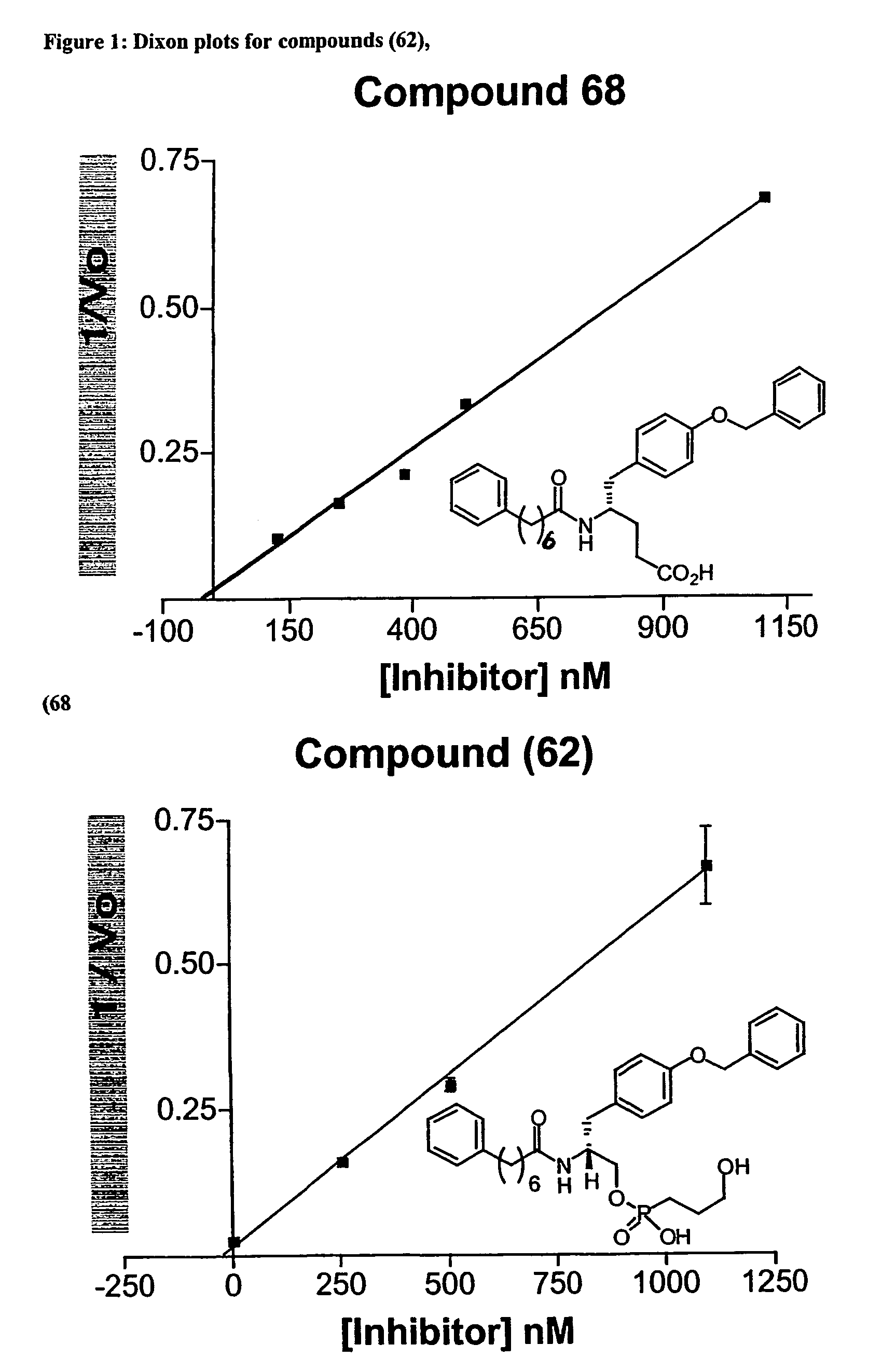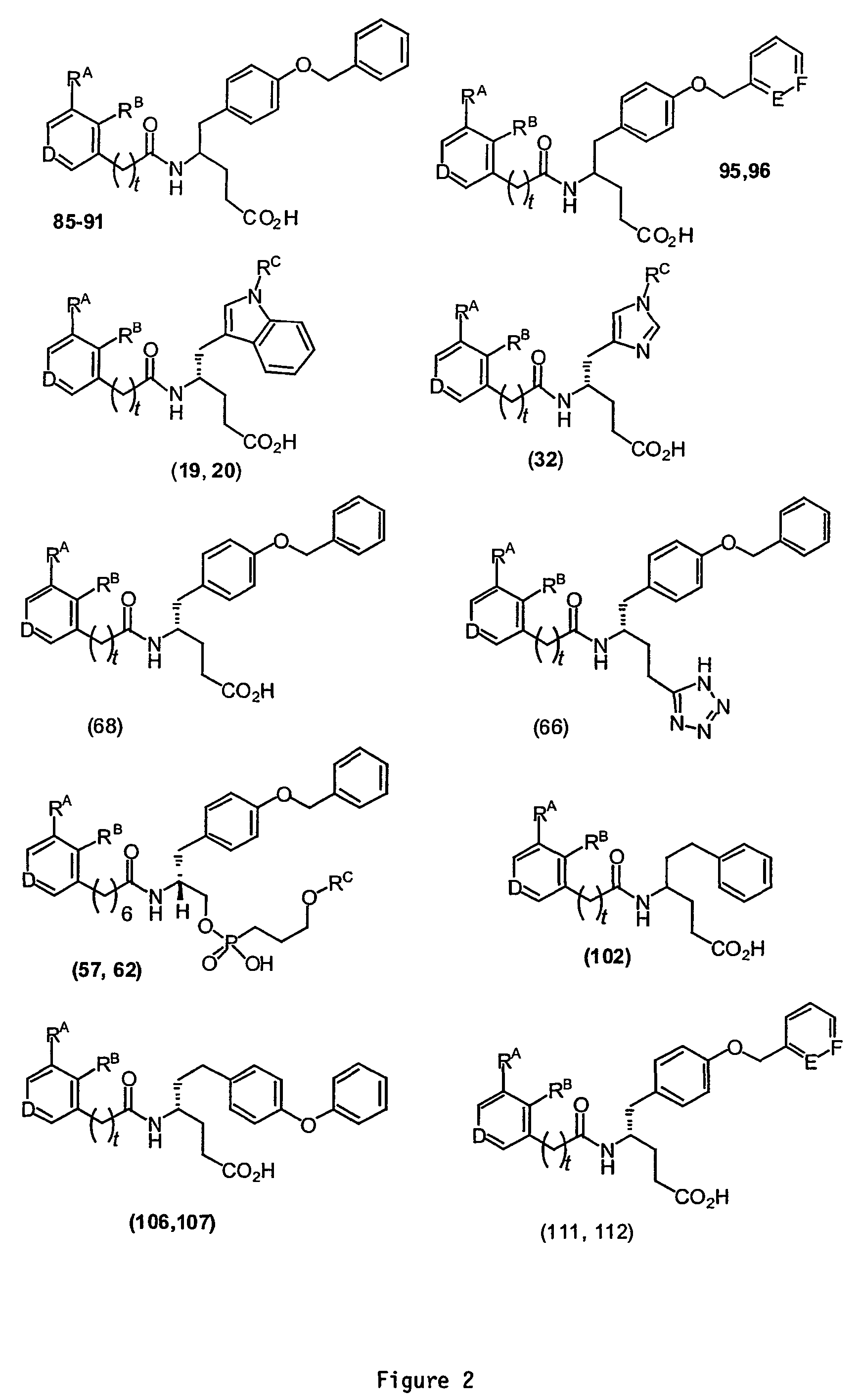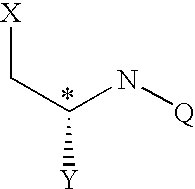Compounds and inhibitors of phospholipases
a technology of phospholipases and inhibitors, which is applied in the field of new inhibitors of secretory phospholipases a2, can solve the problems of long excessive spla/sub>levels, and many of these compounds are incorrectly attributed with the desired activity,
- Summary
- Abstract
- Description
- Claims
- Application Information
AI Technical Summary
Benefits of technology
Problems solved by technology
Method used
Image
Examples
example 1 (
See Scheme 1)
(R)-2-tert-Butoxycarbonylamino-3-(1H-indol-3-yl)-propionic acid benzyl ester(2)
[0194]A solution of Boc-D-tryptophan (25 g, 82.24 mmol), BnBr (14.76 g, 10.25 ml, 86.35 mmol) and K2CO3 (28.37 g, 0.206 mol) in DMF (350 mL) was stirred overnight at room temperature. The solvent was removed and the residue taken up into water and CH2Cl2. The organic layer was washed successively with water and brine and then dried over MgSO4. The solution was filtered and the solvent removed to afford crude product. Recrystallisation from EtOAc gave the title compound as a white solid (24.05 g, 74%). mp 141.4-142° C. 1H NMR (CDCl3) δ 7.98 (1H, br s), 7.55 (1H, d, J=7.68 Hz), 7.08-7.35 (9H, m), 6.81 (1H, br s), 5.09 (2H, d), 3.29 (2H, d, J=5.37 Hz), 1.42 (9H, s). 13C NMR (CDCl3) δ 172.4,155.5, 136.3, 135.4, 128.6, 128.5, 127.7, 123.1, 122.1, 119.6, 118.8, 111.4, 109.8, 80.1, 67.2, 54.5, 28.4, 28.1. ISMS: 395 (M+H),
(R)-3-(1-Benzyl-1H-indol-3-yl)-2-tert-butoxycarbonylamino-propionic acid benzyl...
example 2 (
See Scheme 2)
2-tert-Butoxycarbonylamino-3-(1H-imidazol-4-yl)-propionic acid benzyl ester (22)
[0213]2-tert-Butoxycarbonylamino-3-(1H-imidazol-4-yl)-propionic acid (25 g, 97.92 mmol), benzyl bromide (17.59 g, 12.2 mL, 0.103 mmol) and potassium carbonate (16.9 g, 0.122 mol) in DMF (250 mL) were stirred overnight under argon. The solvent was removed and the residue taken up into water and CH2Cl2. The organic layer was washed with water and brine, dried and filtered. The solvent was removed and the residue subject to column chromatography (silica gel, 75% EA / PE to afford 3-(1-benzyl-1H-imidazol-4-yl)-2-tert-butoxycarbonylamino-propionic acid benzyl ester (6.79 g, 16%) Rf 0.6, followed by 10% MeOH / EA to afford the title compound (15.832 g, 47%) Rf 0.1). ESMS 346 (M+H+) Mpt 100.5-101.7° C. 1H NMR (500 MHz, CDCl3) δ 1.42 (9H, s), 3.02 (2H, m), 4.51 (1H, m), 5.19 (1H, d, J=12.1 Hz), 5.08 (1H, d, J=12.1 Hz), 5.81 (1H, m), 7.35 (5H, m), 7.47 (1H, s). 13C NMR (CDCl3) δ 28.22, 29.48, 53.67, 66.8...
example 3 (
See Scheme 3)
2-tert-Butoxycarbonylamino-3-(3-phenyl-allyloxy)-propionic acid 3-phenyl-allyl ester (34)
[0224]To a stirred solution of Boc-L-serine (5.0 g, 24 mmol) in DMF (20 mL) was added sodium hydride (60% in oil, 1.95 g, 48 mmol) portionwise over 20 minutes, with ice cooling. The first equivalent produced a clear solution of mono-sodium salt, the second equivalent produced a colourless precipitate. The ice bath was removed and stirring was continued for 30 minutes. The solution was again cooled in ice and cinnamyl bromide (7.2 ml, 9.60 g, 48 mmol) was added dropwise over 10 minutes. The mixture was stirred at room temperature for 2 hours and the solvent was removed under reduced pressure. The residue was partitioned between water (200 mL) and ether (200 mL) and the organic extract was washed with water (2×200 mL), dried (Na2SO4), filtered and evaporated under reduced pressure to yield a slightly cloudy yellow oil. 1H NMR (CDCl3) δ 7.60-7.10, (10H, m, ArH), 6.65 (1H, d, J=15.37 Hz...
PUM
| Property | Measurement | Unit |
|---|---|---|
| enantiomeric excess | aaaaa | aaaaa |
| enantiomeric excess | aaaaa | aaaaa |
| enantiomeric excess | aaaaa | aaaaa |
Abstract
Description
Claims
Application Information
 Login to view more
Login to view more - R&D Engineer
- R&D Manager
- IP Professional
- Industry Leading Data Capabilities
- Powerful AI technology
- Patent DNA Extraction
Browse by: Latest US Patents, China's latest patents, Technical Efficacy Thesaurus, Application Domain, Technology Topic.
© 2024 PatSnap. All rights reserved.Legal|Privacy policy|Modern Slavery Act Transparency Statement|Sitemap



